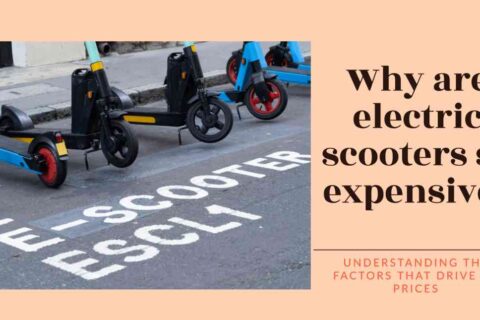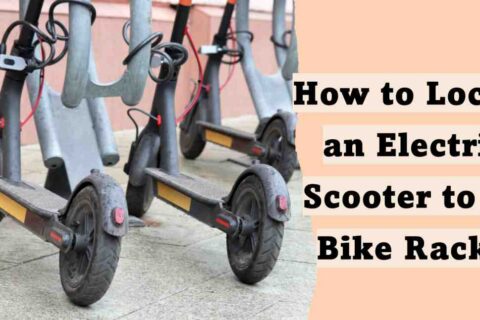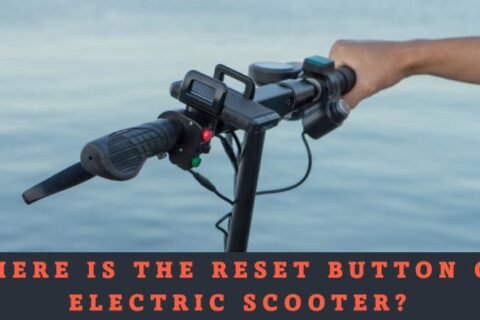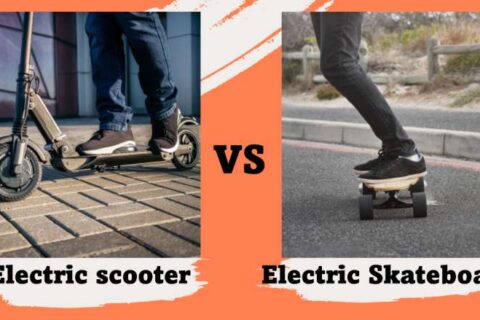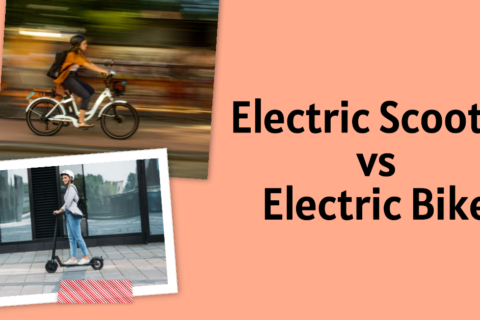Are you interested in trying out an electric scooter for the first time? So here we are with a full beginner’s guide for exploring the significance of learning how to ride an electric scooter.
Furthermore, we will emphasize the distinctions between learning how to ride an electric scooter and other vehicles, with an emphasis on ease of operation, balance, stability, speed, and agility.
By knowing these characteristics, beginners can approach electric scooter riding with the proper mindset and expectations, laying the groundwork for a successful learning experience.
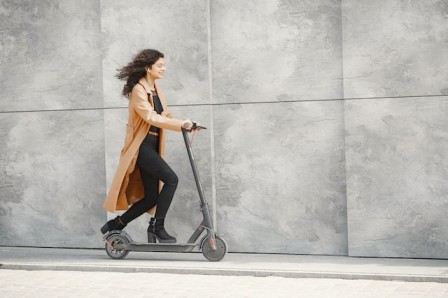
Table of Contents
TogglePrior to Beginning Your Electric Scooter Ride
Emphasizing the Importance of Safety:
Prioritize safety before embarking on your electric scooter riding adventure. Consider the following crucial points:
- Wearing a Helmet and Protective Gear:
The primary concern should be to protect your head. Always use an electric scooter helmet that is correctly fitted and fulfills safety regulations. Consider using knee and elbow pads, as well as wrist guards, to reduce the chance of injury in the event of an accident or fall. - Protective gear:
While not required, wearing protective gear such as long sleeves, slacks, and closed-toe shoes can give an additional layer of protection. It protects your skin from potential abrasions and road rash. - Identifying Potential Risks and Injuries:
Make a point of emphasizing the dangers of riding an electric scooter. Uneven surfaces, barriers, or collisions with other vehicles can all cause accidents. Understanding the potential hazards allows you to ride with prudence.
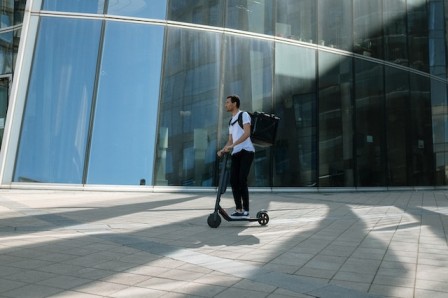
Finding an Open and Safe Place to Practice:
Once you’ve gathered all of the required safety equipment, it’s important to find a suitable spot to practice riding your electric scooter. Take a look at the following:
- Avoiding Traffic and Crowded Areas:
When first starting out, avoid busy roads, intersections, and crowded areas. Look for quieter streets or trails where you can concentrate on your scooter-handling abilities without being distracted. - Using an Empty Parking Lot to Learn:
An empty parking lot is great for novices to practice riding their electric scooters. It gives a controlled atmosphere with plenty of room to maneuver and become acquainted with the scooter’s controls. - Investigating Scooter Behavior and Controls:
Consider how your electric scooter reacts to acceleration, throttle sensitivity, and braking. Increase your speed gradually as you grow acquainted with the scooter’s capabilities. Take note of how it handles turns and maneuvers since this will allow you to anticipate and alter your riding technique accordingly.

Getting to Know Your Electric Scooter:
Before hitting the road, take the time to get to know your electric scooter better:
- Understanding Acceleration and Throttle Sensitivity:
The acceleration and throttle sensitivity of electric scooters varies. Spend some time experimenting with gentle acceleration and finding the ideal balance for your comfort level. - Getting to Know Your Brakes and Adjusting Them:
Learn how to use your electric scooter’s braking system. Test the brakes at various speeds to determine their response. If necessary, study the user manual or get professional assistance to fine-tune the brakes to your liking. - Understanding the Dashboard and Its Functions:
Each electric scooter has a dashboard or control panel that shows vital information. Take the time to learn how it works, including the battery indications, speedometer, and any other characteristics unique to your scooter type like Bluetooth connecting features, etc. Being aware of these factors improves your riding experience.
How to Ride an Electric Scooter – The Steps
Step-by-Step Guide to Riding an Electric Scooter:
STEP 1:
Getting the Scooter Ready for Use
Check that the scooter is in good working order before you begin riding. Examine the brakes, check the tires for wear or punctures, and make sure all of the lights and indicators are working.
STEP 2:
Starting Up and Making Sure You Have a Full Charge
If your electric scooter has a power switch, turn it on. Make sure the battery has an adequate charge for the desired ride by checking the battery level. To maximize your riding duration, it’s recommended to start with a fully charged battery.
STEP 3:
Finding a Comfortable Riding Position and Changing the Kickstand
If your scooter has a kickstand, retract it before you start. With your feet slightly apart, take a comfortable stance next to the scooter. Keep your shoulders back and your hands firmly on the handlebars.
STEP 4:
Properly Place Your Feet on the Deck for Balance
On the deck, place your feet parallel to one another, one foot slightly in front of the other. While riding, this position offers superior stability and balance. Make sure your weight is spread equally between the two feet.
STEP 5:
Gradually Increasing Speed and Acclimating to the Power
To accelerate, turn the throttle slowly. Start with the slowest speed setting on an electric scooter if one is available. As you gain comfort and familiarity with the scooter’s power, gradually increase your speed.
STEP 6:
Brake Effectively
To brake, lightly squeeze the handlebar-mounted brake lever. Regenerative braking is a common feature of electric scooters, slowing the vehicle down and simultaneously charging the battery. To prevent abrupt stops or sliding, practice using calm, progressive braking.
STEP 7:
Understanding Wheel Behavior and Tire Grip
As you ride, pay attention to how the wheels behave and how the tires grip. Watch out for slick areas, gravel, and unlevel ground that might influence traction. To ensure stability, ride at a safe speed and modify your technique as necessary.
STEP 8:
Turns and Maneuvers
As you get more accustomed to riding straight, try practicing turns and maneuvers at low speeds. While maintaining a firm grip on the handlebars, shift your weight slightly in the direction of the turn. Beginning with wider turns, go on to tighter ones as your confidence increases.
Pro Tips for Beginners:

- Starting Slowly and Gradually Increasing Speed:
It’s important to start your electric scooter riding excursion at a reasonable and comfortable speed. As you acquire confidence and greater familiarity with how the scooter handles, gradually increase your speed. You may gradually gain steadiness and control using this method. With this strategy, you may gradually gain stability and control. - Riding with a More Experienced Partner:
If at all feasible, go with another electric scooter user who is more seasoned. They may provide you with advice, impart their wisdom, and share helpful hints for enhancing your riding abilities. Your confidence and sense of security can both increase when you are riding with an experienced companion. - Highlighting the Importance of Continuous Learning:
Riding an electric scooter is a skill that can be learned over time. Even after mastery, there is always space for development. Maintain your curiosity and openness to new approaches, safety procedures, and riding ideas. Investigate online resources, join rider groups, and attend courses or classes to improve your knowledge and abilities.
Know the General Road Rules
Emphasizing the Need to Know Traffic Laws:
It is important to be informed of local traffic rules and regulations when riding an electric scooter. Understanding and following these principles ensures your safety as well as the protection of others.
- Pay attention to traffic signs: Stop at red lights, let people cross the street, and drive in the proper direction.
- Respect pedestrian right-of-way: When crossing sidewalks or designated pedestrian areas, give pedestrians the right-of-way.
- Use designated bike lanes or pathways: To ride your electric scooter safely, use bike lanes or trails wherever possible.
- Respect speed restrictions: Follow established speed limits and adjust your speed to the road conditions and surrounding surroundings.

Understanding the Consequences of Not Following Rules:
Failure to obey traffic laws when riding an electric scooter might result in harsh repercussions. It not only jeopardizes your safety but also that of pedestrians and other road users.
- Increased accident risk: Disobeying traffic rules increases the likelihood of a collision, which can result in injury to yourself and others.
- Legal ramifications: Violations of traffic laws can result in fines, points on your driving record (if applicable), and potentially a suspension of your electric scooter privileges.
- Damage to reputation: Irresponsible riding behavior reflects negatively on electric scooter users as a whole, perhaps leading to negative perceptions and restrictions imposed by authorities.
Comparing E-Scooters to Bicycles and Potential Misconceptions:
Electric scooters are often compared to bicycles due to their shared characteristics. However, it’s important to address potential misconceptions and distinguish them from bicycles. Some key points include:
- Differences in size and speed: Compared to bicycles, electric scooters are often smaller and have higher top speeds. Riders will need to adjust as a result since their behavior and handling characteristics may change.
- Legal distinctions: Electric scooters and bicycles may be subject to separate laws and regulations. To ensure compliance, familiarize yourself with the local laws that regulate electric scooters.
- Public perception: Some individuals could erroneously believe that electric scooters can be used in the same ways as bicycles. By acting responsibly and obeying traffic laws, electric scooter users can help to foster a favorable perception of them.
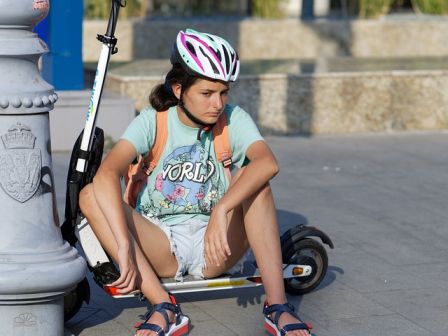
Common Mistakes to Avoid
Do Not Twist the Throttle Too Firmly
One typical error made by novice drivers is to twist the throttle too firmly, which causes a fast acceleration and loss of control. Remember to use a progressive throttle input to prevent this. As you develop confidence and get more accustomed to the scooter’s power, start out with modest spins and raise the throttle gradually.
Promoting Controlled and Smooth Braking Techniques
Controlled, smooth braking is necessary for riding an electric scooter safely. Steer clear of abrupt, hard braking since it might lead to skidding or loss of balance. Instead, apply the brakes gently so that the scooter may slow down without any abrupt stops. To accomplish smooth stops, practice finding the ideal balance between braking force and speed.
Cautioning Against Excessive Leaning in Turns
It’s crucial to maintain stability and balance when taking turns. Avoid leaning too much, since this might make it more likely that you will topple over. Instead, concentrate on minimally changing your body weight in the direction of the turn while maintaining the upright position of the scooter. Through the turn, this method aids in maintaining stability and control.
Reminder to Prevent Excessive Handlebar Rotation
Excessive handlebar rotation is a typical error that might result in loss of control. Avoid twisting the handlebars suddenly or too far when performing turns. To manage curves smoothly, utilize soft, progressive steering inputs. Keep in mind that little modifications are typically enough to preserve stability and control during turns.

When Things Goes Wrong
A. Recognizing the Risk of Accidents:
Accidents can still occur despite all the safety procedures and safeguards in place. It’s crucial to be aware of this possibility and psychologically ready for it. You may preserve your sense of responsibility and remain alert by being aware that accidents might happen when using an electric scooter.
B. Emphasizing the Importance of Personal Safety:
If you are in an accident or are having a terrible day while using your electric scooter, put your personal safety first. If you are in an accident or fall, take a moment to check on yourself to make sure you are safe. Keep your cool and, if at all feasible, relocate to a secure area.
C. Promoting Seeking Medical Attention if Required:
It’s critical to seek medical care right away if you sustain injuries in an accident or experience any pain or discomfort. Even though they initially seem insignificant, injuries should never be ignored. To fully diagnose and manage your problem, it is essential to speak with a healthcare provider because certain injuries may have delayed symptoms.
Source: Big Rise in Injuries From E-Scooters, Hoverboards
Navigating Different Terrains and Conditions
Riding on Smooth Pavements and Sidewalks:
- Maintaining Control and Stability on Even Surfaces – When riding on smooth pavements and sidewalks, keep control and stability in mind. Maintain a relaxed and focused body while equally dispersing your weight on the scooter. This improves balance and control, especially when dealing with surface variances.
- Being Aware of Pedestrians and Sharing Space – When riding on sidewalks or shared paths, always prioritize pedestrian safety. When approaching congested areas, slow down and allow pedestrians the right of way. Be courteous, declare your presence when necessary, and keep a safe distance from walkers, joggers, and other users of the shared path.
Dealing with Uneven Terrain and Obstacles:
i. Methods for Getting Around Cracks and Bumps:
- Allow your legs to serve as shock absorbers by bending your knees just a little bit.
- To stay balanced, slightly shift your weight backward before the obstacle and then forward after it.
- Hold the handlebars firmly and rely on them to provide leverage and stability.
ii. Handling Grass, Gravel, and Other Difficult Surfaces:
- Reduce your speed and proceed with caution while approaching these surfaces.
- Maintain stability by moving at a steady and regulated speed.
- Avoid abrupt braking or acceleration, since this may result in traction loss.
- Lean forward slightly and concentrate on maintaining balance by distributing your weight evenly on the scooter.
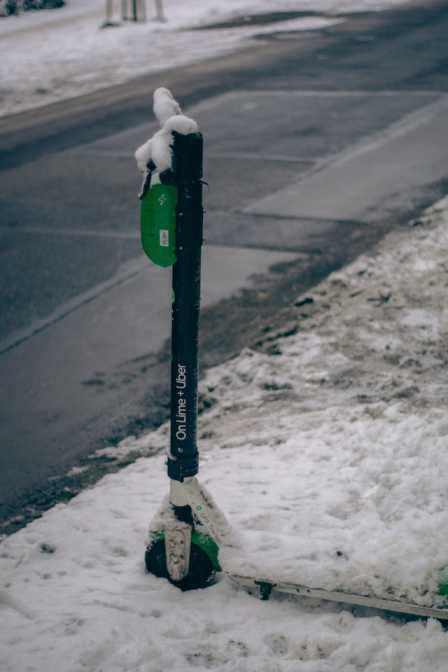
Riding in Various Weather Conditions:
i. Tips for Rain, Snow, and Wet Surfaces:
- To compensate for decreased traction, drop your speed and allow for more braking distance.
- Keep an eye out for slick surfaces, such as painted road lines or metal grates.
- To keep control, use additional caution when turning or changing directions.
- Consider wearing waterproof clothes and luminous apparel or accessories to increase your visibility.
ii. Adjusting Speed and Maintaining Visibility in Adverse Weather:
- Slow down to enhance response time and preserve control.
- Use lights, reflectors, or brightly colored clothes to increase your visibility.
- Maintain your concentration and be mindful of other cars and pedestrians, as vision may be impaired.
Exploring Advanced Riding Skills and Techniques
Riding at Higher Speeds:
- Gradually Increasing Speed and Practicing Control:
You might wish to ride your electric scooter at faster speeds as you develop expertise and confidence. To keep control, it’s crucial to gradually increase your speed. Practice smooth, steady acceleration to make sure you can handle the scooter’s increasing power while gradually stretching the boundaries of your comfort zone. - Keeping a Safe Distance and Being Aware of the Road Around You:
It’s important to keep an eye on the road and your surroundings when riding at greater speeds. Always keep a safe space between your car, your bicycle, and any pedestrians. To guarantee a safe and comfortable ride, be proactive in scanning the road ahead, using mirrors where available, and anticipating potential dangers.
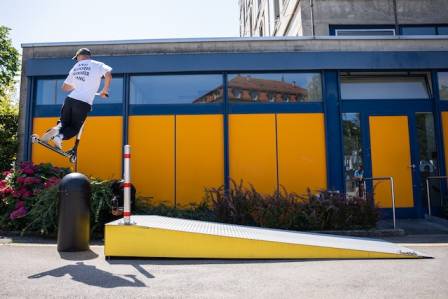
Mastering Complex Maneuvers:
- How to Perform Figure Eights, U-turns, and Other Advanced Turns:
You can travel precisely and through confined locations by mastering intricate turns and maneuvers. Practice U-turns, figure-eights, and other complex turns in a safe setting, such as a parking lot that’s vacant. To perform these moves with assurance, pay close attention to your body’s position, weight distribution, and the seamless operation of the throttle and brakes. - Developing Advanced Braking Techniques for Emergency Situations:
Having the ability to brake effectively in an emergency situation may prevent accidents. To become comfortable with the scooter’s braking capabilities, practice severe braking in a safe area. Always remember to use even pressure on both brakes while maintaining balance and the center of gravity. Increase brake pressure gradually to prevent skidding or losing control.
Riding in Traffic and Urban Environments:
- Understanding Traffic Flow and Lane Positioning:
When riding in traffic or in metropolitan areas, it is critical to understand how traffic moves and to position oneself correctly. Stay in the proper lane and follow the overall flow of traffic. Position yourself to be visible to other drivers, and scan your surroundings with mirrors and quick head checks. - Using Hand Signals and Communicating with Other Drivers:
Effective communication with other drivers improves safety. To express your intentions, like turning or changing lanes, use hand signals. Make eye contact with drivers and pedestrians to let them know you’re there. Being a proactive and thoughtful road user contributes to a safer riding experience for everybody.
Conclusion
I hope this comprehensive beginner’s guide has provided you with how to ride an electric scooter with valuable insights and practical tips. As someone who has experienced the joys and challenges of riding an electric scooter, I understand the importance of safety, responsible behavior, and continuous learning.
Remember to prioritize your well-being by wearing protective gear, practicing safe riding habits, and being aware of your surroundings. Gradually build your skills, explore different terrains, and embrace the freedom that electric scooter riding offers.
By following the guidelines outlined in this article, you can confidently navigate the streets, enjoy the convenience of electric scooters, and contribute to a sustainable and efficient mode of transportation. So, gear up, hop on your electric scooter, and embark on an exciting journey of exploration, adventure, and mastery!
Frequently Asked Questions
Is electric scooter hard to ride?
Electric scooters are intended to be user-friendly, however, the amount of difficulty might vary. Riding an electric scooter is simple and pleasurable for most people with experience and respect for safety precautions.
How to ride scooter safely?
Always use safety gear such as a helmet, elbow, and knee pads, and gloves when riding a scooter. Understand and follow traffic laws, such as traffic lights and right of way. Wear bright clothes and utilize lights on your scooter to make yourself visible to other road users. Stay attentive and alert, minimize distractions, and be aware of any threats in your surroundings.
Is electric scooter faster than bike?
Because of their electric motors, electric scooters may attain faster speeds than regular pedal-powered bikes. Some electric scooters may achieve speeds of 15-25 mph (24-40 km/h) or greater, although ordinary bike speeds range between 10 and 20 mph (16 and 32 km/h).



